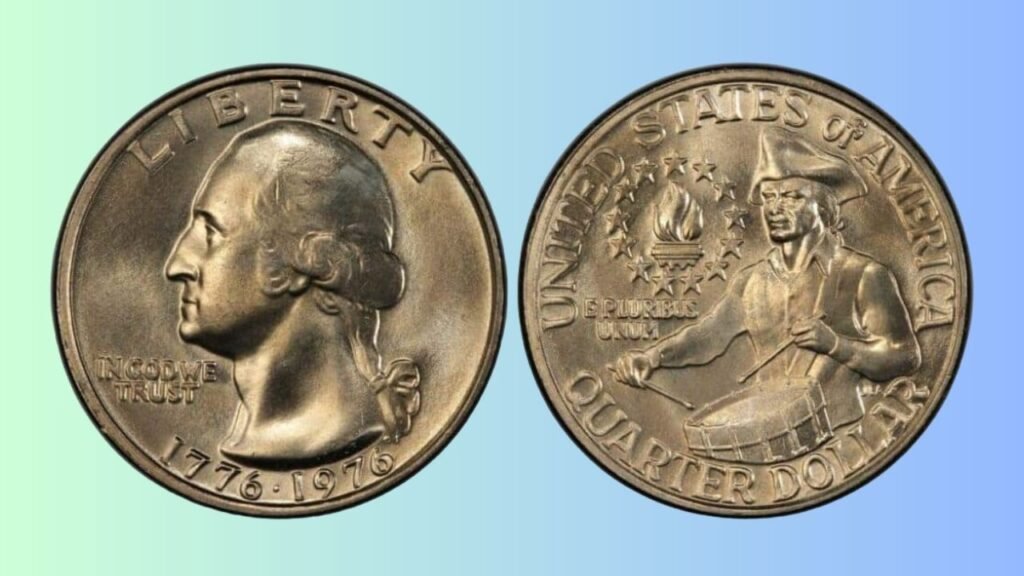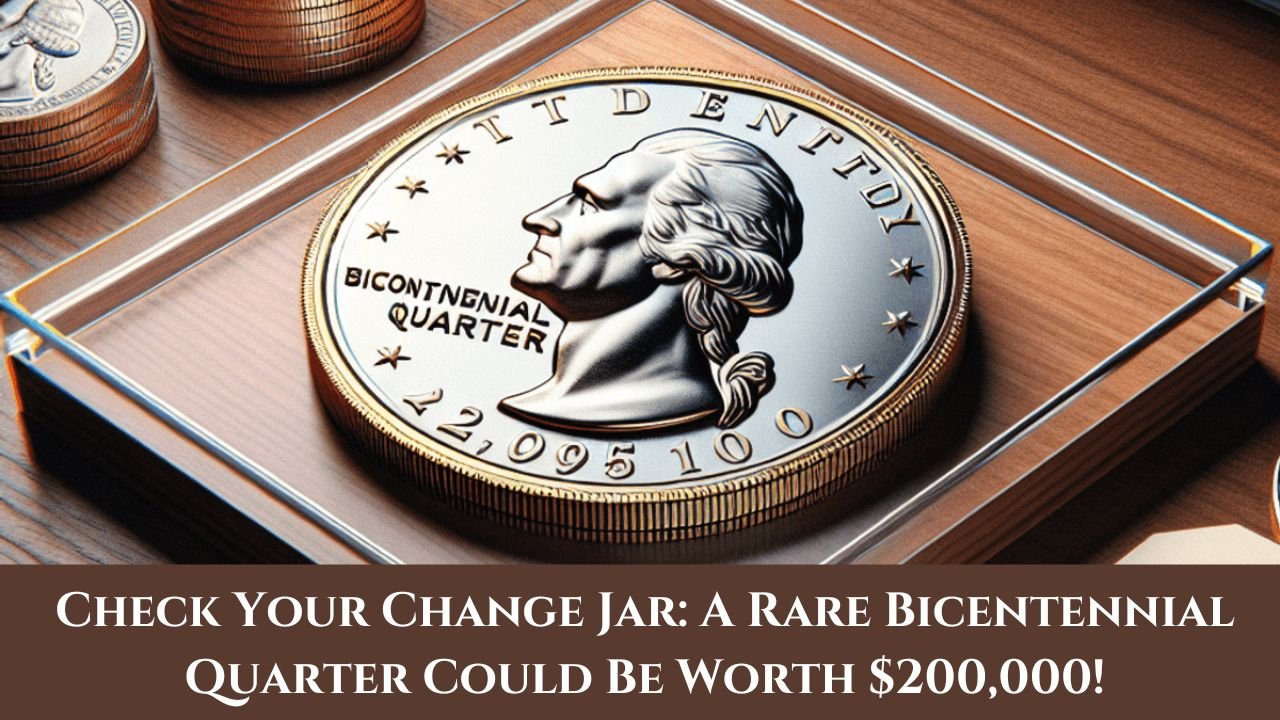Introduction
Those simple changes that gather dust in your bottle may be worth more than you think. Tucked away in ordinary surroundings could be a rare treasure – a bicentennial quarter worth about $200,000.
Produced in 1975 and 1976 to celebrate America’s 200th birthday, these special buildings caught the attention of collectors and numismatists worldwide Although most priced at 25 cents during the bicentennial though, precise changes that are rarely observed can result in astronomical prices at auction.
Do you have a stash of coins, and you want to make that spare change into some small fortune? Let’s dive into what makes quarters collectible and how you can identify some hidden gems in that coin jar today.
Understanding the Bicentennial Quarter
The Bicentennial Quarter was part of the American coin history book. Issued from 1975-76 by the United States Mint, it commemorated the 200th anniversary of the birth of the United States of America.
Design Features
On the flip side of the coin is a colonial drummer who is turned to the left and a triumphal torch encloses him, within it being 13 stars, for the original colonization. This time around, instead of the normal marking on top, it clearly states the years “1776-1976.” The front has the traditional picture of George Washington, but with two dates now on the coins.
Production Details
Production of these four facilities has begun in July 1975 in the US. in three different offices.
- Philadelphia: No mint mark
- Denver: “D” mint mark
- San Francisco: “S” mint mark
U.S. The Mint produced a bicentennial total of 1.7 billion pieces, including all copper, nickel and silver. This huge turnout showed how excited the country was to celebrate five hundred years of independence. These four sites became a currency and also a body expression of American history.
Symbolism Behind the Design
These four sites have been given an editor named Jack L. McCarthy to the trilogy. Each of the designing elements has some symbolic representations – such as the representation of the drummer as being an American fighting spirit, and the lantern as something representing knowledge and understanding.
Rare Variations of the Bicentennial Quarter
The banking world is buzzing with excitement over the distinctive features of the 1976 Bicentennial that command an astronomical valuation. This rare species stands out among the millions of farms regularly cultivated during the commemorative season.
1. 1976 Bicentennial Quarter Silver Proof

The Silver Proof conversion represents the culmination of two hundred years of quarterly collections. This unique coin contains 40% silver and displays the San Francisco Mint’s distinctive “S” gold mark. Defining characteristics include:
- A mirror-like material that absorbs light
- Razor-sharp design details on both sides
- Snowfall in older areas
- Well-defined deep markings
- Accurate edge reading
Collectors win these great pieces of silver for their superior craftsmanship and minimalist design. In pristine condition, these four sites can fetch $25 to $50 for typical samples, while rare variations with unique characteristics or defects can reach into the thousands
The Silver Proof centenary market remains strong, driven by:
- Dedicated collectors interested in complete sets
- Historical Interpretation
- Potential investments
- Limited availability
- Growing American interest in nuclear power
Awards professionals play an important role in adopting this valuable model. The highest grades (MS-69 and MS-70) attract serious collectors and investors, especially when the coin retains its original mint packaging and certificate
The silver items add intrinsic value beyond the collector’s cash, making these four areas tangible investments in precious metals alongside their monetary value.
2. 1976 Bicentennial Quarter Double Die Obverse

The double die obverse is one of the most valuable mint errors in bicentennial history. This rare variation occurs when a coined die takes on two different shapes at slightly different angles during hubbing
The resulting error has a noticeable two-fold effect on specific designs:
- “1776” is double visible in the date.
- Double-click on the word “REQUIREMENTS.”
- There is a distinct disconnect in the descriptions of Washington
- the obvious doubling in the motto “IN GOD WE ARE JEHOVAH.”
These two-die examples command more attention from serious collectors, with older examples selling for $150,000 to $200,000 at major auctions The price increases exponentially as the money lays what it has shown little impurity and retains its original mint sheen no.
It was less than 100 verified second-century mortality doublings that have been attested; this makes this type exceptionally rare. Collectors would prize such specimens for the unique fault characteristics and for their historic importance to American numismatics.
3. Bicentennial Quarters without a Mint Mark

The bicentennial quadruplets struck at the Philadelphia Mint have a special feature: they have no mint marks. This seemingly simple quality offers great value to collectors, especially when these coins are in excellent condition.
The front lacks the mint mark below the date. Instead of a letter like “D” for Denver or “S” for San Francisco, you’ll see a blank space. These four unmarked sites are interesting bicentennial coins.
The value of these coins depends largely on how well they have been preserved:
- MS-65 award: $50-$100
- MS-66 award: $150-$300
- MS-67 award: $500-$1,000+
These four unmarked sites are highly prized by collectors for their historical significance and extreme rarity. Compared to other banks, the Philadelphia Mint produced these coins in small quantities, making them especially desirable.
When looking at your quarters, look for pieces that show minimal simplicity, sharp design details and original mint luster. The flute’s clear and defined lines on the back and the butterfly feathers should remain simple and distinct.
Interestingly, the 1976 Bicentennial also has unique features and values that every serious collector should look for.
Noteworthy Examples of High-Value Quarters
The rare bicentennial world has seen some astronomical observations that might give collectors breath. A prime example is the legendary 1976 bicentennial quarter with a planchette error, costing more than $1.2 million. This particular coin was struck on a 90% silver planchet instead of the standard copper-nickel.
Here are some other high-value bicentennial highlights that made headlines:
- 1976-S Silver Proof Quarter graded MS-68 selling for $48,000 at a 2019 auction
- Several die obverse specimen fetched up to $185,000 at individual sales
- A rare “No S” mintmark card commanded $200,000 at a special coin sale
Valuable models often combine several unique characteristics:
- Clean state: dirty or minimal contact
- Error Surface: Planchet errors, die errors, or stroke anomalies
- Certification: Professional awards and certifications
- Historical Writings: Revealed History as Sources and Owners
This unique coin combined with historical significance and rarity is a prime example of how manufacturing deficiencies can create coin treasures worth more than their absolute value Anything found in a quarter that serves of great value adds interest to the collection and reinforces the power stored in daily cash.
Conclusion
Your change jar might hold surprising treasure. The $200,000 value of this rare third year of a bicentennial attests that coins we get in change every day can be an extraordinary treasure. Start sifting through your quarters today; look for mint marks, analyze conditions, and learn what special features might be hidden inside.
Financial benefits and personal well-being: there are both in the fundraising world. You can be part of local fund groups, connect with other fundraisers, and engage in fundraising. Your journey as a fundraiser starts with just a quarter, but you will make some amazing discoveries and have long-lasting relationships with such passionate communities.
FAQ’s
What is a Bicentennial Triennial?
Bicentennial Quarter represents U.S. coins issued from 1975 to 1976 to mark U.S. 200 years of independence with unique design depicting great historic background.
Why do you look for a change in my bottle after 200 years?
Rare Bicentennial Quarter changes, like the 1976 silver proof and double die front, can be worth a fortune, with some valued at $200,000 or more If you look in your change cupboards, you could find hidden treasures!
What is the nature of the rare 1976 Bicentennial Silver Proof?
The 1976 Bicentennial Quarter Silver Proof has a proof and, being silver in nature, is pretty collectible in the market. Market values could vary considering condition as well as how much a collector is interested.
Does the mint mark affect value on the quarter?
Mint marks are those marks on the coin which indicate that what coin was minted, where it was minted and can have a big influence on the value of a coin. Coins with rare mint imperfections or lacking mint marks are worth more than the rare ones.

